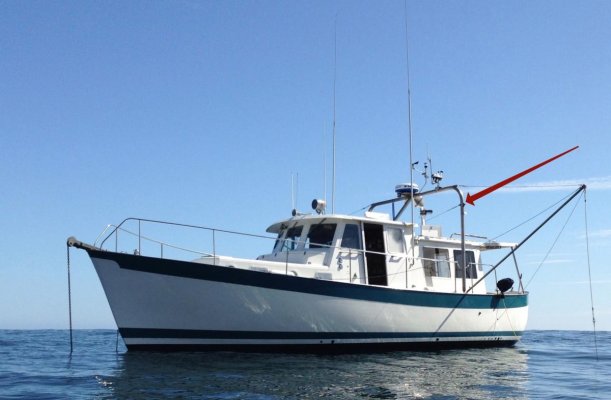Trawler_traveler
Veteran Member
- Joined
- Mar 26, 2017
- Messages
- 89
- Location
- Where the anchor is
- Vessel Name
- Shiplet
- Vessel Make
- 382 Diesel Duck
We've experimented with our paravanes after replacing cables and doing some other servicing to the rig. Now I have some questions for those of you who have used them in the past or are still using them.
- Our booms have a second boom that can be deployed to keep the boom from lifting up (Beebe calls them arm Braces). I have tried to imagine deploying that boom without committing suicide since the inboard/higher attachment point is just about unreachable without hanging out over the side of the boat from the upper dinghy deck. We're inclined to put those booms in storage but wonder under what circumstances such a boom might be required ?
- Beebe says that you chose the downward angle of your fish based on your speed. How sensitive is this setting ? Should we just leave it where it is (far back for slow running) or is it worth experimenting ?
- Beebe refers to some Canadian studies which he states make it obvious that the fish should be connecting to the tow-line with an anchor swivel. Does anyone here know what studies those are or why the swivel is needed ?
- Have any of you run with the fish i the water and then have the weather turn so nasty that you wish you could retrieve them before they become wrecking-ball missiles ?
I'm sure I have more questions but that will have to do for now.
Thanks.
-Sven
- Our booms have a second boom that can be deployed to keep the boom from lifting up (Beebe calls them arm Braces). I have tried to imagine deploying that boom without committing suicide since the inboard/higher attachment point is just about unreachable without hanging out over the side of the boat from the upper dinghy deck. We're inclined to put those booms in storage but wonder under what circumstances such a boom might be required ?
- Beebe says that you chose the downward angle of your fish based on your speed. How sensitive is this setting ? Should we just leave it where it is (far back for slow running) or is it worth experimenting ?
- Beebe refers to some Canadian studies which he states make it obvious that the fish should be connecting to the tow-line with an anchor swivel. Does anyone here know what studies those are or why the swivel is needed ?
- Have any of you run with the fish i the water and then have the weather turn so nasty that you wish you could retrieve them before they become wrecking-ball missiles ?
I'm sure I have more questions but that will have to do for now.
Thanks.
-Sven

